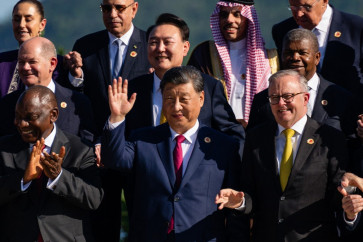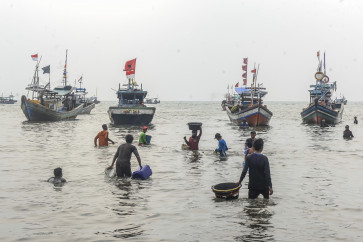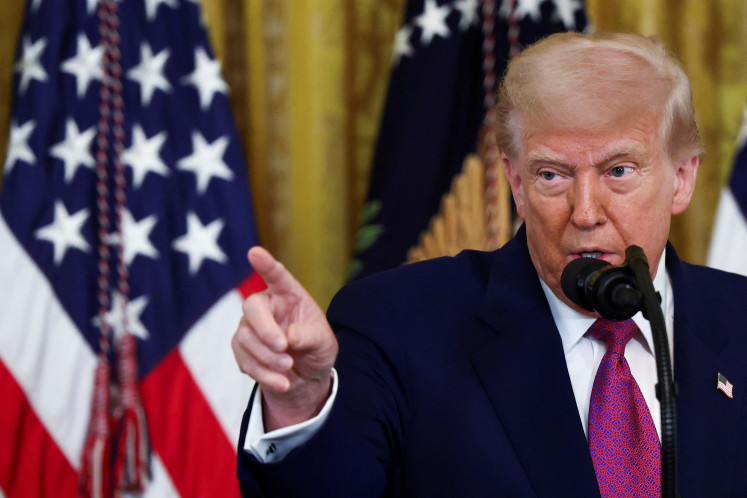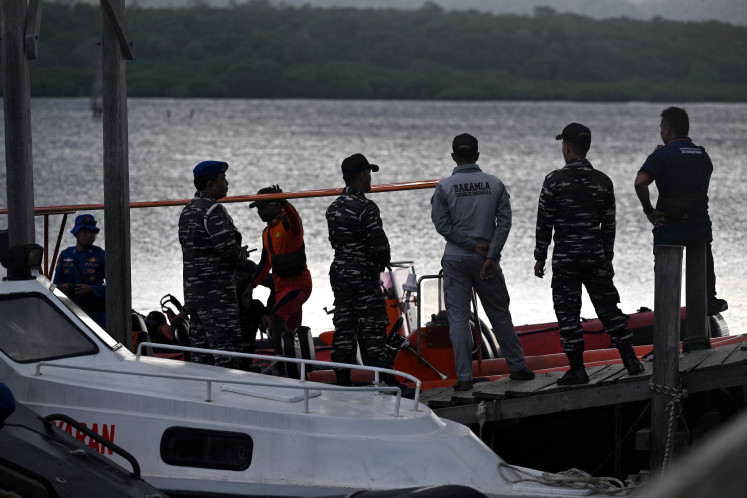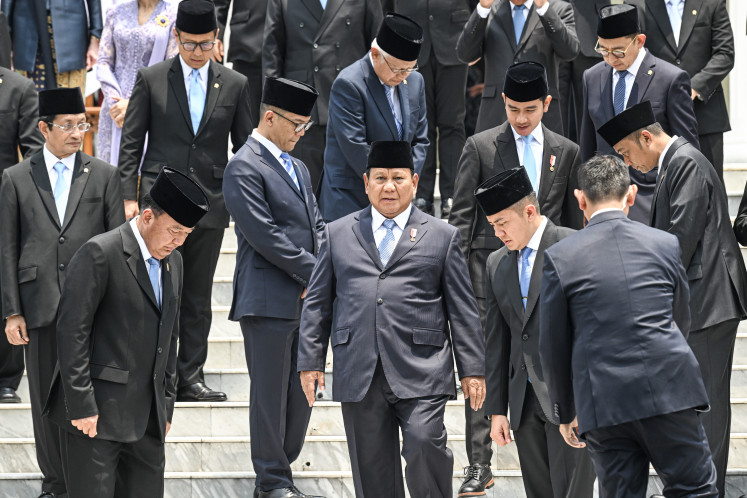Popular Reads
Top Results
Can't find what you're looking for?
View all search resultsPopular Reads
Top Results
Can't find what you're looking for?
View all search resultsIndia's soft power approach can contribute to Indonesia's growth
In the light of India's recent attempt to build closer relations with East Asian countries within the framework of India's Look East Policy, it is pertinent to have a few thoughts on how its soft power could form bases of cooperation with countries like Indonesia, for example
Change text size
Gift Premium Articles
to Anyone
In the light of India's recent attempt to build closer relations with East Asian countries within the framework of India's Look East Policy, it is pertinent to have a few thoughts on how its soft power could form bases of cooperation with countries like Indonesia, for example.
India's Look East Policy in recent years has assumed a greater economic dimension than a parallel political, strategic or even cultural one. Given India's economic reforms and the attendant effort to integrate with the regional and global economy, it is but natural that Indian diplomacy, particularly in its relation with ASEAN countries, will focus more on economic issues like trade, investment, goods and services. And India's success in this sphere is quite significant, as India has become an integral part of Asian political and economic integration
The region now looks towards India because of its potential as an economic powerhouse and partly to balance China's overwhelming economic and strategic influence. However, compared with the clout it has achieved as an economic player, its strategic role in the security of Southeast and East Asia is still quite marginal, notwithstanding its status as a nuclear power and the second largest country in Asia.
Apart from its participation in the ARF dialogues and occasional forays into the Straits of Malacca for patrolling the area to help Indonesia in combating piracy, India still is a marginal player in the security structure of the region.
Promotion of India's strategic objectives need not be through the projection of its hard military power as the "Realist" school would have us believe, but could be more effective through the exercise of its "soft" power, namely, education, culture and democracy. The liberal institutional approach emphasizes soft power aspects with cultural attraction, ideology and international institutions as the main resource.
India's ability to play a major role in Asia lays not so much in the area of trade and investment of the region where China has overwhelming presence, but in her human resource, democracy and culture in which she has comparative advantage over other Asian countries. Knowledge of English, language of globalization is also another advantage.
India's democracy may be messy but it has also shown a lot of creativity in managing a multiracial and multicultural society in place, and in the process of people's empowerment. It is here that India can make an abiding contribution to the process of democratization and nation building of the region by helping them in human resource development and democratic capacity building.
The Western model of democracy is not much of relevance to these countries, as the societal and historical circumstances are quite different. India's experience in nation building and democracy is much more relevant to them. Organizing elections for a potential constituency of 670 million voters is an incredible undertaking that India is proud of.
Indonesia can learn much from the speed and transparency with which votes are tallied and the extensive powers accorded to the Electoral Commission (EC). India can also learn from Indonesia's recent experience of how it is managing its difficult transition from an authoritarian polity to a democratic one.
Indonesia polity today perhaps is the most decentralized one in Asia. However, while it has already implemented devolution of power hoping that a fairer distribution of national wealth will reduce separatist sentiments and regional violence, there is a lack of institutions at local level to absorb such autonomy.
This is where India can offer help through its I-tech (technical cooperation) program, training in local self-government and institution building at the grassroots level, as India has fairly successfully managed its center-state relations through institutions and bargaining federalism.
Another area is in the field of higher education. Undoubtedly Indonesia has been one of the prominent beneficiaries of our technical cooperation programs meant for fellow developing countries. Around 1000 Indonesian experts as well as officials received training in India under ITEC. India offered more than 1100 scholarships to Indonesian students to study at Indian universities.
In May last year, India opened a US$750,000 Vocational Training Centre and it will open another one in Aceh soon. But there are far greater potentials for India-Indonesia cooperation in education benefiting both the countries. India has a lead in information technology and India's technological and management institutes, such as IITs and IIMs, have a very high reputation.
Yet another area is its culture. Indian culture is an inseparable part of Indonesian customs, and our cultures and values are closely related, bearing in mind the history of the civilizational contacts between India and Indonesia which span over 2000 years. Cultural interactions can further cement the bond based on our pluralist and secular traditions and our need for maintaining "unity in diversity", the basic philosophy of our states.
Promotion of tourism as a means of people to people contact can be an important source of our strength and synergy in civil society interactions. Indonesia happens to be the largest Muslim country in the world, yet its cultural heritages are essentially Hindu-Buddhist in origin manifesting in temple architectures of Prambanan and Borobudur in Central Java and innumerable Candis scattered all along the area.
While their origin might have been from India, Indonesia has contributed quite significantly in improvising and enriching that culture. Indian tourists could be encouraged to travel in larger numbers to those sites to discover the inherent genius of the Indonesian people in preserving that culture and values, and in the process the common bond between the two countries.
Similarly, Islamic cultural heritages and monuments are part of India's composite civilization, which need to be presented before the Muslims of Indonesia. Taj Mahal, Fatehpur Sikri, Ajmer, Delhi, Hyderabad, the abode of Tipu Sultan in Mysore and innumerable Islamic cultural sites and Sufi shrines in India could be a spiritual feast for the Indonesian Muslim tourists.
For pilgrimage, Muslims all over the world will surely go to Mecca, the birthplace of Prophet Mohammed, but for spiritual experiences, they need to be exposed to India in discovering pluralism and multiculturalism in India and how Islamic values and cultures have blended into the Hindu ones.
Similar things can be done with Buddhist heritages in India. Nalanda is one of the oldest universities in the world, whose revival in the coming years with the help of countries like Singapore, Japan, South Korea, and China is a move hailed by all Buddhists. Other than Bodh Gaya, Sarnath, Nalanda could be a place for pilgrimage for the Buddhists of Indonesia.
The Nalanda project with mentors like Amartya Sen envisages setting up of an international university, recalling the glorious past of the 5th century, making the future university as an "icon of Asian renaissance" and a "centre of civilizational dialogue and inter-faith understanding." The vision for setting up such an institution was first spelt out by former President A P J Abdul Kalam. Durable and abiding relationships are based not on inter-governmental contacts, but on people-to-people contact. Nalanda can be the bridge between peoples of Asia.
The writer is Distinguished Fellow, Institute of Peace and Conflict Studies, New Delhi.



